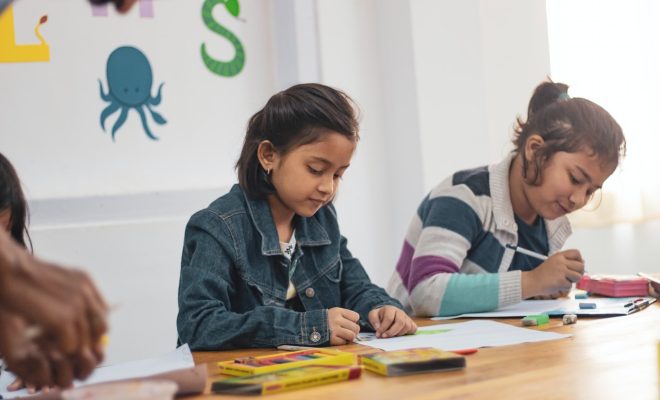Developmentally Appropriate Milestones for 8, 9, and 10-Year-Olds

8, 9, and 10-year-olds are developing strong connections with adults outside the home. Educators, coaches, and other trusted grown-ups have a tremendous influence as mentors and role models. 1-on-1 conversations with adults allow the kid to feel competent, capable and valued. They are often helpful and cheerful in the classroom but may become sullen if they feel ignored.
Free play often finds kids polarized by gender; boys tend to play with other boys while girls play with other girls, and the groups may avoid or antagonize 1 another. At this age, kids are embarrassed easily and may seek to conform to a group instead of risking standing out by voicing a differing opinion. In addition, kids become self-conscious about their talents and weaknesses and avoid activities like dancing or drawing if they do not feel as competent as their classmates.
This group demonstrates an increased attention span and can be thoughtful. In the classroom, “busy work” may meet with resistance. On the other hand, educators find that projects that encourage reasoning and appeal to the kid’s romantic nature are well received and often result in excellent educational outcomes. Interest-based activities are popular with the 8-year-old, and they can now embrace hobbies such as photography and weaving with increased success than in the younger years. Student clubs are very popular, fostering a sense of belonging and allowing kids to explore shared interests. Kids also rally behind group efforts such as bake sales and juice stands. Not only do these activities provide a shared objective, but they also mesh with the “middler’s” fascination with money!
At 8, 9, and 10, kids can spend long periods engaged in planning and building activities. Materials like as Lego, K’nex, and Erector sets can fascinate the 8- year-old for hours. They also enjoy using tools to take apart real electronics and telephones. Board games will continue to be popular, and the games of the early elementary years are slowly replaced with more complex games. The 8-10-year-old appreciates having a system and space to save Lego constructions and half-finished boards games and jigsaw puzzles to return to later.
Outdoors, they thrive when given a choice to join in group games or sports or just “hang out.” Kids are growing rapidly during this year and often seem restless and “wiggly.” In addition to outside time, they enjoy frequent opportunities to move throughout the day. Possibilities include active games, such as “Simon Says” during transition times; opportunities to walk around, stand, sit, or stretch out on a soft rug in the indoor environment; and even materials that can allow limited gross motor play in the classroom, such as a hopscotch mat or Nerf basketball hoop.
Responding to 8-, 9-, and 10-Year-Olds
Take time to talk with kids about their thoughts, ideas, and interests.
Offer various choices and select open-ended activities that do not lead kids to judge their efforts as “good” or “bad” compared to others.
Use stories and role-play to encourage kids to care for 1 another and “do the right thing.”
Offer materials and guidance to encourage kids to explore new interests. Possibilities include kids’ animation software, microscopes, musical instruments, and materials for making jewelry. Consider offering clubs to allow kids with similar interests to work together.
Invite guests to share their topics of interest with the kids. Visitors such as park rangers, athletes, musicians, and artists can spark new interests, provide hands-on experiences to support learning, and offer meaningful interactions with adults.
Provide a wide variety of appealing, age-appropriate materials for construction, as well as puzzles.
8-year-olds are likely to be offended by materials designed for younger kids, such as Duplos or beginning reader books. Avoid materials that will lead kids to believe that they are too old for the provided activities.
Do not assign writing projects in afterschool and out-of-school environments, but encourage kids to explore the purposes that writing can serve. They may enjoy scripting a play, writing and illustrating books for younger kids, creating secret codes, or writing letters to pen pals.
Value kids as competent learners and offer materials in response to their interests. An enthusiastically motivated group of middlers can accomplish almost anything.






